热释电红外传感器简介
- 格式:doc
- 大小:41.00 KB
- 文档页数:7
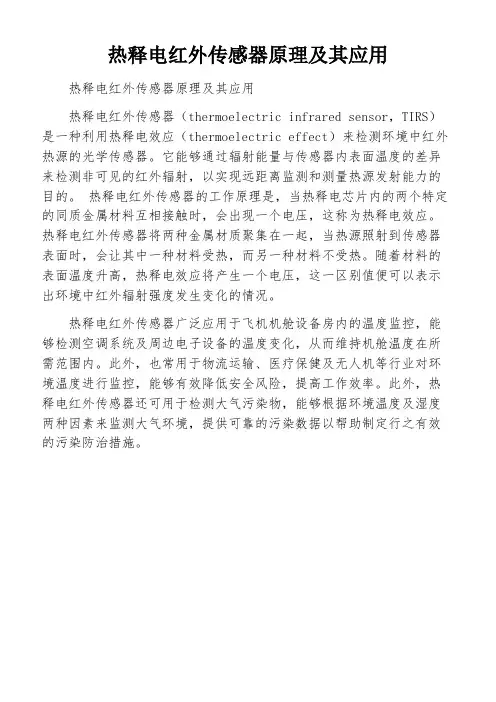
热释电红外传感器原理及其应用热释电红外传感器原理及其应用
热释电红外传感器(thermoelectric infrared sensor,TIRS)是一种利用热释电效应(thermoelectric effect)来检测环境中红外热源的光学传感器。
它能够通过辐射能量与传感器内表面温度的差异来检测非可见的红外辐射,以实现远距离监测和测量热源发射能力的目的。
热释电红外传感器的工作原理是,当热释电芯片内的两个特定的同质金属材料互相接触时,会出现一个电压,这称为热释电效应。
热释电红外传感器将两种金属材质聚集在一起,当热源照射到传感器表面时,会让其中一种材料受热,而另一种材料不受热。
随着材料的表面温度升高,热释电效应将产生一个电压,这一区别值便可以表示出环境中红外辐射强度发生变化的情况。
热释电红外传感器广泛应用于飞机机舱设备房内的温度监控,能够检测空调系统及周边电子设备的温度变化,从而维持机舱温度在所需范围内。
此外,也常用于物流运输、医疗保健及无人机等行业对环境温度进行监控,能够有效降低安全风险,提高工作效率。
此外,热释电红外传感器还可用于检测大气污染物,能够根据环境温度及湿度两种因素来监测大气环境,提供可靠的污染数据以帮助制定行之有效的污染防治措施。
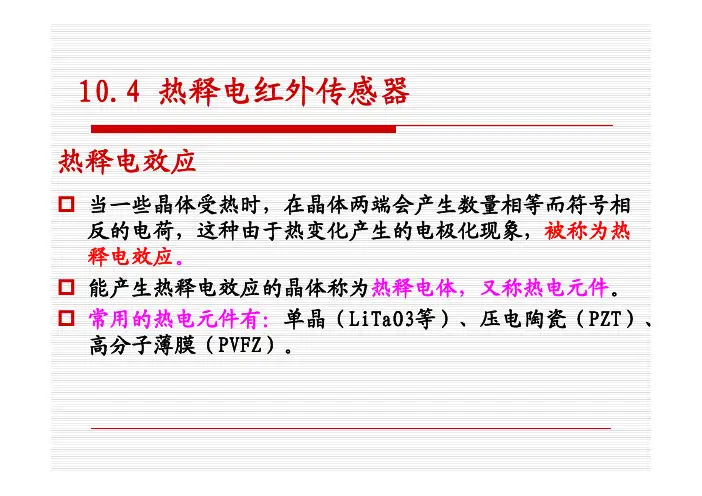
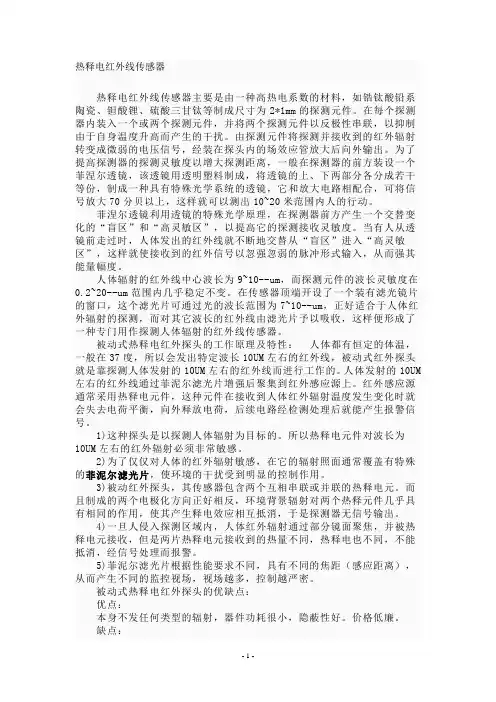
热释电红外线传感器热释电红外线传感器主要是由一种高热电系数的材料,如锆钛酸铅系陶瓷、钽酸锂、硫酸三甘钛等制成尺寸为2*1mm的探测元件。
在每个探测器内装入一个或两个探测元件,并将两个探测元件以反极性串联,以抑制由于自身温度升高而产生的干扰。
由探测元件将探测并接收到的红外辐射转变成微弱的电压信号,经装在探头内的场效应管放大后向外输出。
为了提高探测器的探测灵敏度以增大探测距离,一般在探测器的前方装设一个菲涅尔透镜,该透镜用透明塑料制成,将透镜的上、下两部分各分成若干等份,制成一种具有特殊光学系统的透镜,它和放大电路相配合,可将信号放大70分贝以上,这样就可以测出10~20米范围内人的行动。
菲涅尔透镜利用透镜的特殊光学原理,在探测器前方产生一个交替变化的“盲区”和“高灵敏区”,以提高它的探测接收灵敏度。
当有人从透镜前走过时,人体发出的红外线就不断地交替从“盲区”进入“高灵敏区”,这样就使接收到的红外信号以忽强忽弱的脉冲形式输入,从而强其能量幅度。
人体辐射的红外线中心波长为9~10--um,而探测元件的波长灵敏度在0.2~20--um范围内几乎稳定不变。
在传感器顶端开设了一个装有滤光镜片的窗口,这个滤光片可通过光的波长范围为7~10--um,正好适合于人体红外辐射的探测,而对其它波长的红外线由滤光片予以吸收,这样便形成了一种专门用作探测人体辐射的红外线传感器。
被动式热释电红外探头的工作原理及特性:人体都有恒定的体温,一般在37度,所以会发出特定波长10UM左右的红外线,被动式红外探头就是靠探测人体发射的10UM左右的红外线而进行工作的。
人体发射的10UM 左右的红外线通过菲泥尔滤光片增强后聚集到红外感应源上。
红外感应源通常采用热释电元件,这种元件在接收到人体红外辐射温度发生变化时就会失去电荷平衡,向外释放电荷,后续电路经检测处理后就能产生报警信号。
1)这种探头是以探测人体辐射为目标的。
所以热释电元件对波长为10UM左右的红外辐射必须非常敏感。

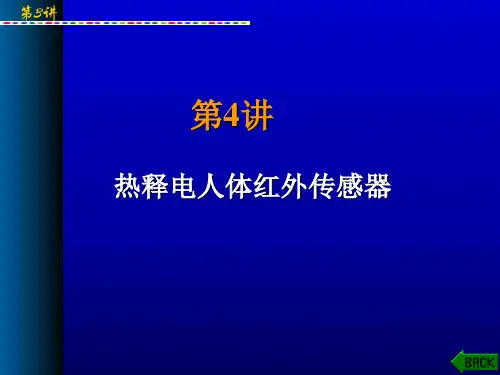
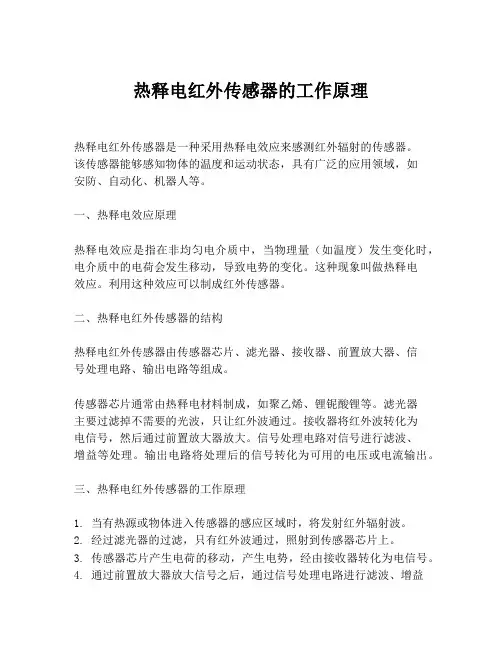
热释电红外传感器的工作原理热释电红外传感器是一种采用热释电效应来感测红外辐射的传感器。
该传感器能够感知物体的温度和运动状态,具有广泛的应用领域,如安防、自动化、机器人等。
一、热释电效应原理热释电效应是指在非均匀电介质中,当物理量(如温度)发生变化时,电介质中的电荷会发生移动,导致电势的变化。
这种现象叫做热释电效应。
利用这种效应可以制成红外传感器。
二、热释电红外传感器的结构热释电红外传感器由传感器芯片、滤光器、接收器、前置放大器、信号处理电路、输出电路等组成。
传感器芯片通常由热释电材料制成,如聚乙烯、锂铌酸锂等。
滤光器主要过滤掉不需要的光波,只让红外波通过。
接收器将红外波转化为电信号,然后通过前置放大器放大。
信号处理电路对信号进行滤波、增益等处理。
输出电路将处理后的信号转化为可用的电压或电流输出。
三、热释电红外传感器的工作原理1. 当有热源或物体进入传感器的感应区域时,将发射红外辐射波。
2. 经过滤光器的过滤,只有红外波通过,照射到传感器芯片上。
3. 传感器芯片产生电荷的移动,产生电势,经由接收器转化为电信号。
4. 通过前置放大器放大信号之后,通过信号处理电路进行滤波、增益等操作。
5. 处理后的信号通过输出电路转化为可用的电压或电流输出。
四、热释电红外传感器的优缺点1. 优点:响应速度快、结构简单、功耗低、灵敏度高、价格相对较低、在恶劣环境下也可以进行工作。
2. 缺点:受环境影响较大、易受其它电磁辐射的干扰、动态响应能力较差。
综上所述,热释电红外传感器是一种基于热释电效应工作的传感器,其工作原理主要是利用物体的红外辐射,产生电荷移动,最终产生电势并输出信号。
该传感器具有快速响应速度、低功耗、灵敏度高等优点,但受到环境影响较大、易受其它电磁辐射的干扰等缺点。

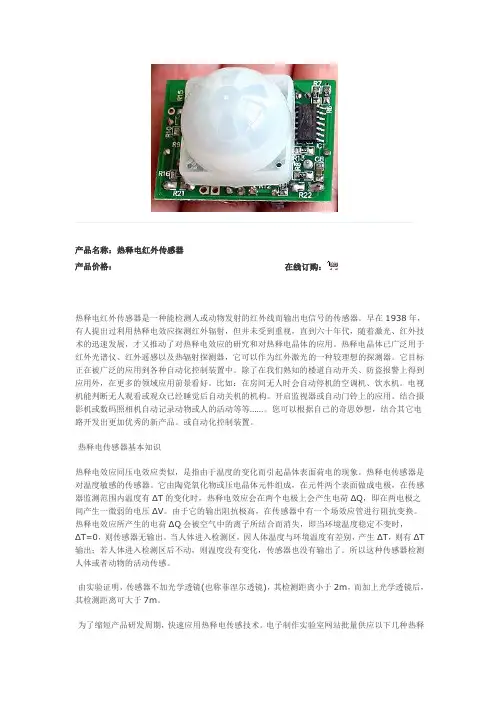
产品名称:热释电红外传感器产品价格:在线订购:热释电红外传感器是一种能检测人或动物发射的红外线而输出电信号的传感器。
早在1938年,有人提出过利用热释电效应探测红外辐射,但并未受到重视,直到六十年代,随着激光、红外技术的迅速发展,才又推动了对热释电效应的研究和对热释电晶体的应用。
热释电晶体已广泛用于红外光谱仪、红外遥感以及热辐射探测器,它可以作为红外激光的一种较理想的探测器。
它目标正在被广泛的应用到各种自动化控制装置中。
除了在我们熟知的楼道自动开关、防盗报警上得到应用外,在更多的领域应用前景看好。
比如:在房间无人时会自动停机的空调机、饮水机。
电视机能判断无人观看或观众已经睡觉后自动关机的机构。
开启监视器或自动门铃上的应用。
结合摄影机或数码照相机自动记录动物或人的活动等等……。
您可以根据自己的奇思妙想,结合其它电路开发出更加优秀的新产品。
或自动化控制装置。
热释电传感器基本知识热释电效应同压电效应类似,是指由于温度的变化而引起晶体表面荷电的现象。
热释电传感器是对温度敏感的传感器。
它由陶瓷氧化物或压电晶体元件组成,在元件两个表面做成电极,在传感器监测范围内温度有ΔT的变化时,热释电效应会在两个电极上会产生电荷ΔQ,即在两电极之间产生一微弱的电压ΔV。
由于它的输出阻抗极高,在传感器中有一个场效应管进行阻抗变换。
热释电效应所产生的电荷ΔQ会被空气中的离子所结合而消失,即当环境温度稳定不变时,ΔT=0,则传感器无输出。
当人体进入检测区,因人体温度与环境温度有差别,产生ΔT,则有ΔT 输出;若人体进入检测区后不动,则温度没有变化,传感器也没有输出了。
所以这种传感器检测人体或者动物的活动传感。
由实验证明,传感器不加光学透镜(也称菲涅尔透镜),其检测距离小于2m,而加上光学透镜后,其检测距离可大于7m。
为了缩短产品研发周期,快速应用热释电传感技术。
电子制作实验室网站批量供应以下几种热释电传感器成品组件。
红外模块使用注意事项:1、人体感应器模块属于高度敏感的器件,它对电源要求很高,必须经过良好的稳压滤波,例如9V的层叠电池就可能因为内阻较大不能正常工作,建议客户用LM7808稳压芯片稳压后再通过220UF和0.1UF的电容滤波后供电。


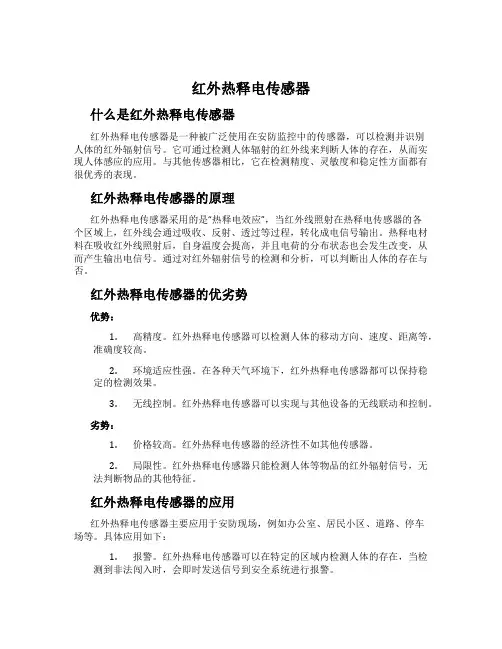
红外热释电传感器什么是红外热释电传感器红外热释电传感器是一种被广泛使用在安防监控中的传感器,可以检测并识别人体的红外辐射信号。
它可通过检测人体辐射的红外线来判断人体的存在,从而实现人体感应的应用。
与其他传感器相比,它在检测精度、灵敏度和稳定性方面都有很优秀的表现。
红外热释电传感器的原理红外热释电传感器采用的是“热释电效应”,当红外线照射在热释电传感器的各个区域上,红外线会通过吸收、反射、透过等过程,转化成电信号输出。
热释电材料在吸收红外线照射后,自身温度会提高,并且电荷的分布状态也会发生改变,从而产生输出电信号。
通过对红外辐射信号的检测和分析,可以判断出人体的存在与否。
红外热释电传感器的优劣势优势:1.高精度。
红外热释电传感器可以检测人体的移动方向、速度、距离等,准确度较高。
2.环境适应性强。
在各种天气环境下,红外热释电传感器都可以保持稳定的检测效果。
3.无线控制。
红外热释电传感器可以实现与其他设备的无线联动和控制。
劣势:1.价格较高。
红外热释电传感器的经济性不如其他传感器。
2.局限性。
红外热释电传感器只能检测人体等物品的红外辐射信号,无法判断物品的其他特征。
红外热释电传感器的应用红外热释电传感器主要应用于安防现场,例如办公室、居民小区、道路、停车场等。
具体应用如下:1.报警。
红外热释电传感器可以在特定的区域内检测人体的存在,当检测到非法闯入时,会即时发送信号到安全系统进行报警。
2.自动开关灯。
在开启了自动感应的灯具中,红外热释电传感器可以检测人体的存在,从而实现灯具的自动开关。
3.智能家居。
将红外热释电传感器应用到家居中,可以通过对家具的感知,实现智能化的控制管理。
红外热释电传感器与其他传感器的区别与其他传感器相比,红外热释电传感器的最大优势在于检测的是人体的红外辐射信号。
与光线传感器、声音传感器等其他传感器相比,红外热释电传感器可以在低光照、较弱声音等条件下工作,并且抗干扰能力较强。
但是,它也有自己的局限性,如无法检测人体之外的物体,且价格和功耗较高。
热释电人体红外传感器摘要:热释电红外传感器是基于热电效应原理的热电型红外传感器,是一种能检测人体发射的红外线的新型高灵敏度红外探测元件。
它能以非接触形式检测出人体辐射的红外线能量的变化,并将其转换成电压信号输出。
将输出的电压信号加以放大,便可驱动各种控制电路。
因此可以用热释电红外传感器用于做电源开关控制器及防盗防火报警器等。
其主要采用被动红外报警的结构,不需要发出任何形式能量,只需要接收自然的能量来达到探测的目的。
关键词:热释电;红外;人体;应用引言:目前我国的传感器很多需要长时间利用电能启动而且灵敏度不高,热释电红外传感器是一种不需要外界能量只需要接收自然能量的传感器且具有很高的灵敏度,是一款结构简单价格低廉而且很节能的产品。
1、热释电陶瓷的性能原理当一些晶体受热时,在晶体两端将会产生数量相等而符号相反的电荷。
这种由于热变化而产生的电极化现象称为热释电效应。
通常,晶体自发极化所产生的束缚电荷被空气中附集在晶体外表面的自由电子所中和,其自发极化电矩不能显示出来。
当温度变化时,晶体结构中的正、负电荷重心产生相对位移,晶体自发极化值就会发生变化,在晶体表面就会产生电荷耗尽。
能产生热释电效应的晶体称为热释电体,又称为热电元件。
热电元件常用的材料有单晶(LiTaO3等)、压电陶瓷(PZT等)及高分子薄膜(PVF2等)。
如果在热电元件两端并联上电阻,当元件受热时,则电阻上就有电流流过,在电阻两端也能得到电压信号。
热释电陶瓷若不考虑温度的不均匀性,热释电体一般具有一级和二级热释电效应。
其中二级热释电效应是由于温度变化引起材料形变,再由压电效应产生电荷的二级效应。
一般情况下,若温度变化率相同,升降温过程中产生的热释电电荷大小相等,但符号相反,其能把光能或热能变成电能。
热释电效应在近10年被用于热释电红外传感器中,广泛地用于辐射和非接触式温度测量、红外光谱测量、激光参数测量、工业自动控制、空间技术、红外摄像中。
热释电红外传感器简介被动式红外探测器不需要附加红外辐射光源,本身不向外界发射任何能量,而是由探测器直接探测来自移动目标的红外辐射,因此才有被动式之称。
被动式红外探测器是利用热释电效应进行探测的。
被动式红外探测器又称为热释电红外探测器,其主要工作原理便是热释电效应。
热释电效应是指如果使某些强介电质材料(如钦酸钡、钦错酸铅P(zT)等)的表面温度发生变化,则随着温度的上升或下降,材料表面发生极化,即表面上就会产生电荷的变化,从而使物质表面电荷失去平衡,最终电荷变化将以电压或电流形式输出。
热释电红外传感器通过接收移动人体辐射出的特定波长的红外线,可以将其转化为与人体运动速度,距离,方向有关的低频电信号。
当热释电红外传感器受到红外辐射源的照射时,其内部敏感材料的温度将升高,极化强度减弱,表面电荷减少,通常将释放掉的这部分电荷称为热释电电荷。
由于热释电电荷的多少可以反映出材料温度的变化,所以由热释电电荷经电路转变成的输出电压也同样可以反映出材料温度的变化,从而探测出红外辐射能量的变化。
红外探测器的光学系统可以将来自多个方向的红外辐射能量聚焦在探测器上,这样红外探测器就可以探测到某一个立体探测空间内热辐射的变化。
当防范区域内没有移动的人体时,由于所有的背景物体(如墙壁、家具等)在室温下红外辐射的能量比较小,而且基本上是稳定的,所以不能触发报警器。
当有人体突然进入探测区域时,会造成红外辐射能量的突然变化,红外探测器将接收到的活动人体与背景物体之间的红外热辐射能量的变化转化为相应的电信号,电信号的大小,决定于敏感元件温度变化的快慢,经过后级比较器与状态控制器产生相应的输出信号U,送往报警器,发出报警信号。
红外探测器的探测波长为8~14um,人体的红外辐射波长正好处于这个范围之内,因此能较好的探测到活动的人体。
被动式红外探测器属于空间控制型探测器,其警戒范围在不同方向呈多个单波束状态,组成锥体感热区域,构成立体警戒。
热释电红外传感器说明热释电红外传感器,这名字听起来是不是挺高大上的?它就是一种能“感知”温度变化的小玩意儿。
它就像是那种“灵敏的探子”,只要有热量经过,它立马就能感应到,真的是太厉害了!想想,如果你家里有个热释电传感器,它就能帮你发现那些“潜伏者”,比如偷偷溜进你家的小猫咪,或者是你正在忙着做饭却忘了关的电炉。
它的原理其实很简单,热释电材料在受到温度变化时,会产生电信号,传递给其他设备。
简单说,它就是一个温度的“侦探”,随时待命,等着捕捉热量的“踪迹”。
这玩意儿广泛应用于各个领域,尤其是安全监控。
想象一下,家里装了这样一个传感器,当有人靠近的时候,它会发出警报,简直就像是家里的“守护神”。
它还能搭配摄像头,瞬间变身为“全能侦探”,让你再也不怕漏掉任何可疑的动静。
你要是晚上睡觉,突然听到一声“嘀嘀”,别紧张,可能是热释电传感器在向你报告:有人来了!这东西也很省电,长时间工作也不用担心它会“罢工”,真是个节能的小能手。
再说说它的应用场景吧,真的是五花八门。
从家居到商业,再到智能交通,几乎无处不在。
在商场里,很多时候你都不知道,其实你身边就有它的身影。
比如说,当你走进一家店里,门口的传感器就会感应到你,自动开门,像个热情的迎宾员。
这种科技感,真让人忍不住想多逛逛。
还有那种智能家居系统,靠着热释电传感器,你的灯可以实现自动开关,晚上起床的时候再也不用摸黑了,想想就觉得方便!热释电红外传感器的优点可真不少。
它的响应速度极快,瞬间就能捕捉到热量变化,简直不费吹灰之力。
它的安装也超级简单,没啥技术含量,几乎人人都能搞定。
只要把它装在一个合适的位置,就能开始“工作”了!这让不少人都爱上了这个小家伙,像是给家里增添了一个“聪明的小助手”。
也有人觉得它可能会误报,比如当空调突然开起来时,它也许会“以为”有个人在活动,结果发出警报,哈哈,这时候就得自认倒霉了。
不过,热释电红外传感器也有一些小缺点。
比如,价格有点小贵,尤其是高精度的产品。
Pyroelectric infrared sensor Preface Pyroelectric infrared sensor is a very potential applications of the sensor.It can detect people or animals, the infrared transmitter and converted into anelectrical signal output. As early as 1938, it was proposed detection using pyroelectric infrared radiation effect, but not taken seriously. Until the sixties, with the laser, infrared technology is developingrapidly, it has contributed tothepyroelectric effect and research on pyroelectric crystals application development. In recent years, along with the rapid development of integrated circuit technology, as well as the characteristics of the sensor depth study of the relevant application specific integrated circuit processing technology is also growing rapidly. This article first describes the principle of the pyroelectric sensor, and then describe the relevant ASIC processing technology.Pyroelectric effectIn nature, any more than the absolute temperature (-273K) objects will have infrared spectra, objects at different temperatures the wavelength of infrared energyreleased is not the same, so the level of infrared wavelengths is related to temperature, and radiation energy size and surface temperature.1µm wavelength of visible light is usually less, but more than 1µm light the human eye can not see, but can be an appropriate instrument to detect the energy oradiation.When some of the crystal is heated, the crystal will have an equal number of both ends of the opposite sign of charge, such as heat of changes in the polarization phenomenon, known as the pyroelectric effect. Typically, the crystals produced by the spontaneous polarization bound charge is attached to the air from the surface of free electrons in the crystal and in itsspontaneous polarization electric moment can not be demonstrated. When the temperature changes, positive and negative charges in the crystal structure of the relative center of gravity shifts, the spontaneous polarization changes, the crystal surface will have run out of charge, charge depletion is proportional to the polarization degree of the situation, Figure 1 shows thepyroelectric The principle effect of the formation.Pyroelectric effect can produce a crystal or call the pyroelectricpyroelectric body components, the material commonly used in single crystal (LiTaO3, etc.), piezoelectric ceramic (PZT, etc.) and polymer film (PVFZ, etc.) [ 2] When represented LiTaO3 pyroelectric material is self-polarized state, the absorption of infrared incident, the crystallization of the surface temperature change, since the polarization has changed, crystal surface charge becomes imbalanced, the imbalance taken out of charge voltage can be measured by infrared. Pyroelectric materials produced only when the temperature changes the voltage, if the infrared radiation has been, there is no imbalance in voltage, if no infrared radiation, the crystal surface charge on the in an unbalanced state, so the output voltage Pyroelectric infrared sensors, infrared light irradiation due to gain or lose heat and shelter, resulting in voltage output. In principle should be independent of the wavelength, but the material made by the pyroelectric sensor has a light transmission window, the translucent windows and wavelength selection of a relationship. To SiO2 as the window material, such as sensors, it can almost all visible light, while others near the window material can only 4µm wavelength of light, and some wavelengths of light through 6.1µm, and some through 8µm ~ 14µm wavelength of light, so use a different window materials which can be confirmed that the heat generated by the wavelength of light.Quantum-type infrared detectorQuantumponse, response sensitivity and infrared wavelength. The energy generated by each incident photon E = hc / λ = 1124λ Where, h - Planck constant, h = 4.14 × 10-15 (evs) = 6.625 × 10-34 (JS) c - the speed of light, c = 3 × 1010cm / s 1µm infrared light energy 1.24eV, 10µm infrared light energy of 0.12eV, compared with the visible light, infrared light energy smaller. Quantum-type infrared sensor light conductive type and is divided into two kinds of light force. Components of light conductive material PbS, PbSe, Hg, Cd, Te, etc., it is the use of infrared radiation to reduce the characteristics of impedance detection signal to obtain; and light force type is in Ge, IrSb formed on a substrate such as semiconductor PN Results, when the infrared radiation generated when the light force, Ge band gap for the 0.6ev, Ge diode of 0.6µm and 1.9µm more sensitive to infrared light, infrared li ght when the wavelength of the incident in the 0.6µm ~ 1.9µm, in the PN junction force formed with the increase of the amount of incident light, thereby detecting amplified output signal.Pyroelectric sensorPyroelectric sensor using the pyroelectric effect is, is atemperature-sensitive sensor. It consists of oxides or ceramic piezoelectric crystal components, the component made of two surface electrodes, when the temperature within the sensor monitoring the change ∆T, the pyroelectric effect in the two electrodes will produce the charge ∆Q, ie between two electrodes in a weak voltage ∆V. Pyroelectric infrared sensors and thermocouples are based on the principle of thermoelectric thermoelectric infrared sensors. Different pyroelectric infrared sensors is the thermoelectric coefficient is much higher than the thermocouple. Chart Pyroelectric infrared sensor structure and the internal circuit shown in Figure 2. Sensors are mainly case, interference filters, pyroelectriccomponent PZT, FET, FET and other components.FilterHuman central wavelength of infrared radiation 9 ~ 10 - um, the wavelength sensitivity of the detection component in 0.2 ~ 20 - um range is almost constant. The top of the sensor chip has opened a window with filter, this filter through the wavelength range of 7 ~ 10 - um, just right for the detection of infrared radiation in the human body, while the other infrared wavelengths by the filter film to be absorbed, thus forming a special body for detection of infrared radiation sensor. Thermoelectric components Thermoelectric materials will be a certain thickness of the sheet, and in its metal electrodes deposited on both sides, and then power on its polarization, this will make the pyroelectric detectors. As the voltage increases polarization is extremelynature and therefore, the detection element is polarized positive 、 negative in nature. Thermoelectric element within the Seebeck coefficient by the high iron titanate ceramic lead and mercury, and lithium tantalate、 Triglyceride iron sulfate, and its polarization changes with temperature. In order to suppress the temperature change due to their interference can be generated process will be the same two features reverse thermoelectric element connected in series or poor way of balancing the circuit, to suppress its own temperature as a result of the interference. Thus able to detect objects in non-contact infrared energy emitted changes and converts it to electrical signal output.FET impedance transformationPyroelectric infrared sensors in the structure aims to introduce complete FET impedance transformation. Thermoelectric element as is the charge output signal, resistance up to 104M , so the introduction of the N-channel JFET common drain pipe should be connected in the form of that the source followerto complete the impedance transformation. Because of its high output impedance, so the sensor has a field effect transistor for impedance transformation. Pyroelectric effect will be produced by the charge ∆Q with combination of ions in the air disappeared, when the ambient temperature stability constant, ∆T = 0, the sensor no output. When the body into the detection zone, because the body temperature and ambient temperature differential, resulting in ∆T, is a signal output; if the body does not move into the detection zone, the temperature does not change, the sensor has no output, so this sensor can detect body or animal activities.Reference SelectionThe commonly used models of pyroelectric infrared sensors are P228, LHl958, LHI954, RE200B, KDS209, PIS209, LHI878, PD632 and so on. Pyroelectric infrared sensor is usually a 3 pin metal package, the pins are supply-side (internalswitch D pole, DRAIN), signal output (internal switch S pole, SOURCE), ground (GROUND) . Pyroelectric infrared sensors are the main working parameters Voltage (commonly used pyroelectric infrared sensor operating voltage range 3 ~ 15V) Wavelength (typically 7.5 ~ 14 µ m) Source voltage (usually 0.4 ~ 1.1V, R = 47k ) Output signal voltage (typically greater than 2.0V)Note the use of infrared modules:1, the human body are highly sensitive sensor device module, its high power requirements, the regulator must be a good filter, such as cascading 9V battery may not work because of the larger resistance, advises clients to use the LM7808 regulator chip 0.1UF regulator and then through the 220UF capacitor filtered supply. 2, the module does not work properly when connected load, after load connected to the work of disorder, because the power capacity of a small load is power, work load due to voltage fluctuations lead to the module malfunction, the other reason is that the load may causeinterference with electrical work, such as relays or solenoids and other inductive load will produce back EMF, 315M will be launching board work will affect the electromagnetic radiation module. Solution is as follows: A, power supply filter inductor increases. B, by using different load and voltage of the module, for example: load with 24V operating voltage, 12V voltage module, during which three-terminal regulator with the LM7812 isolation. C: with a larger capacity power supply. 3, the body work environment sensor module should avoid sunlight, direct exposure to bright light, if the work environment has a strong radio frequency interference shielding measures can be used. In case of strong flow interference, close doors and windows or to prevent convection. Sensitive area to avoid facing the heating appliances and objects, and debris easily by the wind and clothing 4, the human sensor module must be assembled in a sealed box, otherwise the outputsignal has been there. Sensor (PIR) and the lens has a focusing distance, usually 20-30mm range of adjustment. 5, infrared detectors to detect if the required angle of less than 90 degrees, you can block the lens with opaque tape or cut narrow the lens to achieve. 6, the human body sensor module using a dual probe, the body's limbs and head movement direction and the sensor sensitivity are closely linked, if you set the improper installation, will affect the induced effects. 7, module probe (PIR) for assembly and welding the other side of the circuit board. Probe can also be extended with the dual-core shielded cable, 2 meters length should be as well.ConclusionPyroelectric infrared sensor has low price, technical performance and stability, development using simple One such feature, in addition to the above monitoring alarm and automatic switching of typical applications, in many of its It has wide application areas, such as automatic starting or stopping the air conditioner, water dispenser, TV, automatic Camera filmingthe activities of humans and animals, or digital camera, with the development of electronic technology, heat Pyroelectric infrared sensors will be more widely used in the field of automatic control.。